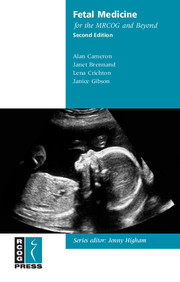Book contents
- Frontmatter
- Contents
- Preface
- Abbreviations
- 1 Screening for chromosomal abnormalities
- 2 Prenatal diagnostic techniques
- 3 The routine anomaly scan
- 4 Fetal structural abnormalities
- 5 Fetal therapy
- 6 Prenatal diagnosis and management of non-immune hydrops fetalis
- 7 Termination of pregnancy for fetal abnormality
- 8 Fetal growth restriction
- 9 Twin pregnancy
- 10 Fetal infection
- Index
2 - Prenatal diagnostic techniques
Published online by Cambridge University Press: 05 August 2014
- Frontmatter
- Contents
- Preface
- Abbreviations
- 1 Screening for chromosomal abnormalities
- 2 Prenatal diagnostic techniques
- 3 The routine anomaly scan
- 4 Fetal structural abnormalities
- 5 Fetal therapy
- 6 Prenatal diagnosis and management of non-immune hydrops fetalis
- 7 Termination of pregnancy for fetal abnormality
- 8 Fetal growth restriction
- 9 Twin pregnancy
- 10 Fetal infection
- Index
Summary
Introduction
Antenatal screening identifies those pregnancies at ‘high risk’ of fetal complications, such as aneuploidy, intrauterine infection and fetal anaemia, but the diagnosis can only be confirmed or refuted by direct examination of fetal tissue or blood. Until recently, fetal cells could only be obtained by an invasive procedure: amniocentesis, chorionic villus sampling (CVS) or cordocentesis. While fetal cells can now be extracted from the maternal circulation and analysed for specific indications, this technique is not widely available and it clinical use remains limited. Invasive testing therefore remains the cornerstone of prenatal diagnosis.
This chapter will focus on the prenatal diagnostic techniques used to determine fetal karyotype. Readers are referred to Chapters 5 and 10 for information on the role of prenatal diagnostic tests in the management of fetal anaemia and intrauterine infection.
Who should be offered invasive prenatal testing?
All pregnant women should be made aware that both diagnostic and screening tests for aneuploidy are available in pregnancy. The majority of women will choose to have a screening test, as this carries no innate risk to the pregnancy, and will not wish to discuss diagnostic testing in any form. For others, the consequences of having a child affected by aneuploidy are of such enormity that no screening test will give sufficient reassurance. If such concerns are expressed, the mother must have ample opportunity to discuss the full range of diagnostic tests that are available. It is for the woman to decide which risk is most acceptable.
- Type
- Chapter
- Information
- Fetal Medicine for the MRCOG and Beyond , pp. 19 - 34Publisher: Cambridge University PressPrint publication year: 2011
- 1
- Cited by

